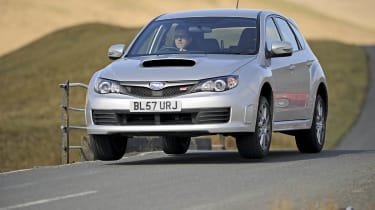Subaru Impreza WRX STi
It took Mitsubishi a long time to realise how well suited the Evo would be to UK roads, but Subaru was much more aware of the benefits of a compact frame, four-wheel drive and a meaty turbo engine
It took Mitsubishi a long time to realise how well suited the Evo would be to UK roads, but Subaru was much more aware of the benefits of a compact frame, four-wheel drive and a meaty turbo engine. The first Impreza caused a sensation, turning Subaru from a farmer’s favourite into a brand with a loyal and passionate sporting fan base.
But what will they make of the latest version? It’s a curious looking thing, with the curved bonnet and roofline giving it a rounded appearance. The gaping bonnet scoop is a direct link to Subaru’s rally heritage and does serve a purpose, as it channels air into the engine’s intercooler. The flared arches are also functional, as they add 55mm to the Impreza’s width, which promises to improve stability and grip.
Aficionados of the brand may be unable to resist the option of WR Blue paint with gold wheels, but we think the Impreza looks more cohesive and upmarket in silver. However, this hint at quality doesn’t continue when you open the door.
The STI costs upwards of £25,000, but the interior design and material quality are no better than on a £10,000 supermini. Cheap plastics and flimsy trim abound, although like the Evo, it gets the basics right. It also adds steering reach adjustment – which the Mitsubishi doesn’t have –offers excellent all-round visibility and has a decent amount of cabin stowage.
Following the practicality theme, there’s plenty of headroom throughout, and the Impreza’s five-door hatchback layout makes it the most versatile of the models on test.
It’s the fastest, too. The larger 2.5-litre flat-four develops 296bhp, which is 5bhp more than the Evo X, and an identical 407Nm of torque – albeit 500rpm further up the rev range at 4,000rpm. However, on the road it’s the Subaru that pulls better from low revs – although neither really gets going until the needle passes 3,500rpm.
But with a kerbweight of 1,505kg – some 85kg less than the Lancer – the Subaru gained a slight acceleration advantage, and its flat-four engine had a much more characterful growl, too. The Si-Drive system alters the engine mapping to improve throttle response, although the Subaru always felt lazier to respond than the Mitsubishi and the Audi. But the main impression you get from the STI is how mechanical it seems.
Where Mitsubishi has thrown electronics and technology at the Evo, Subaru has stuck to tried-and-tested mechanical systems. The six-speed manual has a tight shift and weighty clutch, while the four-wheel-drive transmission uses limited-slip differentials front and rear, which allow torque to be distributed to the wheel that needs it most.
That’s just as well, because the steering is a disappointment. Not only is it too light, but it’s not direct enough, so the nose is vague and agility suffers in comparison to the Evo X. A lower centre of gravity – the engine has been dropped 22mm in the frame – means that although the chassis isn’t anywhere near as stiff as the Lancer’s, it manages to be stable on rough roads.
And it’s absorbent, too. Compared to the Evo, the Impreza has long suspension travel and is softly set-up. That means it copes with B-roads well, although it still fidgets over motorway expansion joints and is just as noisy as the Mitsubishi.
Against its rivals here, the Subaru feels almost rough and ready. But although it’s flawed and comparatively crude, it has plenty of character, and that alone helps make it enjoyable to drive. What’s more, from point-to-point it’s just as quick as the Evo, but costs £7,000 less. Is that enough to give the STI victory?
Details
- Price: £25,095
- Model tested: Impreza WRX STI
- Chart position: 3
- WHY: The Evo’s deadliest rival sits on an all-new platform, and boasts a rally-style 4WD system.
Economy
As with the Evo, the STI runs on super unleaded – so expect to pay about £1.15 a litre, rather than £1.07. Cover 12,000 miles a year, and you’re looking at a £3,230 fuel bill. That’s still £340 less than the Evo, though.
Residuals
No figures are available for the Subaru yet, but given the car’s lukewarm reception, we think residuals will be similar to its predecessor, which held on to about 43 per cent of its price. Expect to lose around £14,000 over three years.
Servicing
It’s not as cheap as the Evo X, but the Subaru’s first two check-ups are well priced. Watch the steep third service, though. The dealers have a good reputation, taking third in the Driver Power 2008 report free with this issue.
Insurance
Weaker residuals account for the Impreza being 20 pence per mile more expensive to run than the Audi. The fact it’s thirstier, costs over £200 more per year to insure, and has a £400 tax disc doesn’t help matters, either.



